Berlinale 2009 - 70mm Retrospective
|
Read more
at in70mm.com The 70mm Newsletter |
| Written by: Thomas Hauerslev (Copenhagen, Denmark) & Paul Rayton (Hollywood, USA) | Date: 03.03.2009 |
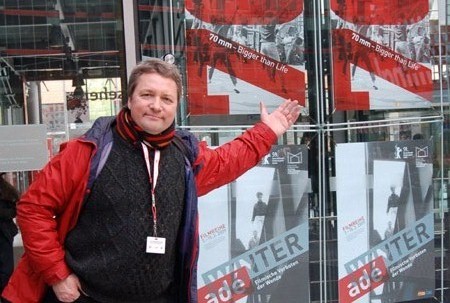 The
editor as pictured by Maria Hauerslev next to a 70mm Retrospective
poster at Potsdamer Platz. The
editor as pictured by Maria Hauerslev next to a 70mm Retrospective
poster at Potsdamer Platz.In October 2008 I received an e-mail from Connie Betz, Retrospective, Programme Coordinator, Deutsche Kinemathek, concerning a 70mm Retrospective season they were planning for the 59th Berlinale film festival in February 2009. She asked me about availability of certain 70mm prints and some other things. I was of course excited about the idea of a full blown 70mm film festival over many days and offered my assistance. The Festival also invited me to come to Berlin and be part of the Retrospective for some days, an invitation which I happily accepted. I also offered Connie to do one of my lectures entitled “The Early Days of Todd-AO” or “The Wonderful World of Film Formats” which I've done in England, Germany, Denmark and in the Czech Republic at 70mm film festivals. But she already had the schedule full. Oh well, maybe another time. The program did sound fantastic. An amazing schedule of 22 x 70mm titles over 10 days, plus 4 x 70mm short films and several lectures, receptions and talks. Impossible to see all of it, unless you live in Berlin. On top of it all would be a book published about 70mm film history. The organizers made a huge effort in getting the new prints of the classic films, or at least some older prints of good quality. By a coincidence, the Berlinale opening film was "The International" by Tom Tykwer, who had used the ARRI 765 camera for several key scenes in the film. |
More
in 70mm reading: Pictures from the festival: 70mm Reception Astor Cinema Cinestar 8 Kurfurstendam Kevin Brownlow Lecture Kino International People and Guests Posters and Signs Memorial Bundestag Checkpoint Charlie Filmmuseum Potsdam Stauffenberg and Bendlerblock Trains New 70mm print of "Flying Clipper" Berlin 2009 - Programme of Events Complete 70mm Retrospective Berlin 2009 |
Significance of 70mm Retrospective |
|
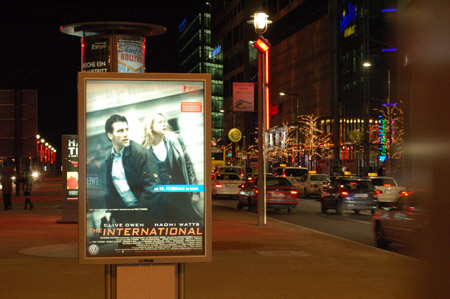 "The
International" poster on Potsdamer Platz. Image by Thomas Hauerslev "The
International" poster on Potsdamer Platz. Image by Thomas HauerslevI don't think the significance of this kind of exposure of 70mm during the Berlinale should be underestimated. It is very difficult to explain to people what 70mm is. It is easy to describe the technicalities of frame size and multichannel sound, but in the end it has to be seen to be understood. And over the past 20 years a small group of dedicated fans have kept the interest going by faithfully attending festivals, and talking and writing passionately about "the good old days" when films were bigger. Some times SO big, that a "Super" or a "70" had to be added to posters! After all these various (mostly) annual gatherings at Bradford(since 1996), Karlsruhe (2005), Oslo (2000), Krnov (2006), and various screenings in Hollywood, Seattle, Austin, plus the occasional shows here and there around the world - now, suddenly, 70mm is given a superior place of recognition, at one of the most important film festivals in the world -- and the audiences responded as if it was their long-lost child! But it took all the years of work, of Bill Lawrence (Widescreen Weekend), Johan Wolthuis (The 70mm Newsletter), Paul Rayton (Egyptian Theatre), Herbert Born (Todd-AO Festival), maybe myself (in70mm.com), several hundred international 70mm fans, and not the least, Schawn Belston (Fox), Grover Crisp (Sony/Columbia), Andrew Oran (FotoKem), etc. to restore these prints. These combined efforts and influences seemingly manifested themselves into one effect - to get the level of "buzz" up to the present level. So now, the Berlinale. It will be interesting to follow in future years how film makers took notice of this (if at all). |
Internet link: youtube.com youtube.com Tagesspiegel Taz Süddeutsche Berliner Morgenpost Projectinist at the Kino International der Fritag Maerkische Allgemeine Variety Deutsche Welle Movie Blogs berlinale.de 70mm retro page Bundesarchiv Filmarhciv kinokompendium.de filmvorfuehrer.de Deutsche Kinemathek - Museum für Film und Fernsehen Berliner Pilsner Filmmuseum Potsdam Deutscher Wiederstand German Resistance Kevin Brownlow Berlin 70mm Retro 2009 Retrospective Hollywood Elesewhere |
70mm Retrospective - Before we arrived |
|
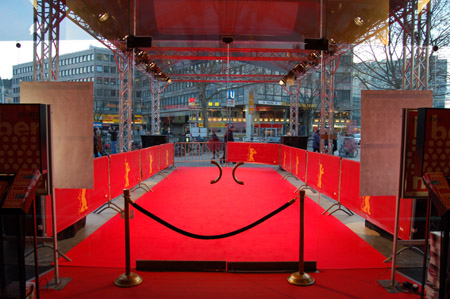 The
red carpet is ready for the 70mm audience. Image by Thomas
Hauerslev The
red carpet is ready for the 70mm audience. Image by Thomas
HauerslevThe Retrospective officially started Friday afternoon at 17:00 with a panel discussion titled "In the Splendour of 70mm. Keeping Wide Gauge Alive" about why 70mm remains very popular and still has an enormous appeal to cinemas and fans alike. Keynote speakers were Schawn Belston (Fox), Herbert Born (Schauburg), Jan Olsen (Oslo), and Patrick Stanbury (Photoplay Productions). The following day another panel discussion took place with film director Tom Tykwer, about why he chose 65mm for some scenes in the "The International". I will attempt to cover some of the highlight of the 70mm Retrospective and Berlinale as we experience it during our first visit to Berlin - a city so rich in film and history. I'm very happy to add Paul Rayton to help chronicle the second part of the Retrospective. |
Programme Coordinator Retrospective Deutsche Kinemathek Connie Betz Museum für Film und Fernsehen Potsdamer Str. 2 10785 Berlin Germany phone: +49 30-300903-25 |
Sunday, 8. February 2009 - Going to Berlin |
|
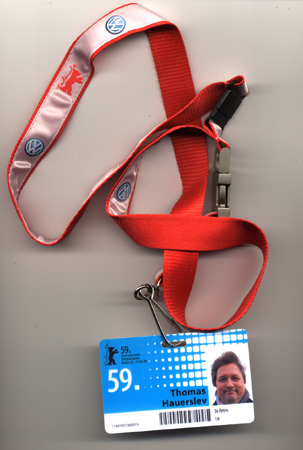 Four months
after The Festival's invitation, my daughter and I (Slightly overweight Danish
eccentric and self-proclaimed "Indiana Jones of 70mm") were boarding the train to
take us
to Berlin - the environmentally friendly approach. I’m tired of
waiting in airports, so I use the train in Europe whenever
possible. There are good direct connections from Copenhagen to
Berlin and I can work - and relax - on the train. The train ride
even includes a ferry trip between Denmark and Germany. A real
adventure in luxury, with lots of leg space and comfortable
seats. Four months
after The Festival's invitation, my daughter and I (Slightly overweight Danish
eccentric and self-proclaimed "Indiana Jones of 70mm") were boarding the train to
take us
to Berlin - the environmentally friendly approach. I’m tired of
waiting in airports, so I use the train in Europe whenever
possible. There are good direct connections from Copenhagen to
Berlin and I can work - and relax - on the train. The train ride
even includes a ferry trip between Denmark and Germany. A real
adventure in luxury, with lots of leg space and comfortable
seats.My daughter (14) is a developing movie fan, and this would be her 5th 70mm Festival and I’m very proud that she wants to spend time with dad like this. She’s well into 70mm film history, and over the years she has managed to see many of the classics in 70mm and Cinerama at both Bradford and Karlsruhe. Promoting 70mm is something I take very seriously, and if I can start with my children and pass on the love for the large format to them, then I'll feel I have achieved something. An early start, 7:42 Sunday morning at Copenhagen's central station. 7 and a half hours later we arrived in the brand new Berlin main station, an impressive building with trains on 8 tracks on the lower level and 6 tracks on the main floor. Herbert Born (Schauburg, Karlsruhe) (Big Karlsruhe film eccentric and self-proclaimed "King of The world" which in fact is the simple truth...) met us at the “Hauptbahnhof”, and kindly drove us to Alte Potsdamer Straße 11 to pick up our accreditation cards and hotel voucher from the Berlinale offices on the 5th floor of the Price Waterhouse Coopers building. By 16:00 we were properly “dressed” with a festival badge and the ubiquitous red festival bag. Maria and I were ready to embrace a few days of fun, friends and 70mm film. |
03.03.2009 Hi Thomas A BIG thank you for your AMAZING write-up on Berlin! It was like being there! I can imagine how much hard work it was and it is very much appreciated. There was so much detail! Great that everybody was there - a truly special event. I haven't even seen all the photos yet! CHEERS Brian Guckian, Ireland 65/70mm Workshop 05.03.2009 Hallo, Mr. Hauerslev, Thank you for your nice report on the wide screen festival in Berlin in 70mm.com . You tried hard in writing it. I noticed that you have written that the screen size of the International Cinema is only 14x6 m. In my minds eye it must be a little bit larger as you can see in the follwing cinema-description-link: there the screen size is given as 17x9,2 m. Many greetings from Berlin from a 70mm fan. Gerhard Witte, Berlin |
The reception |
|
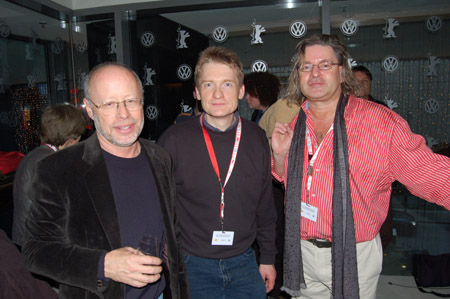 Mark
Magidson (Magidson Film), Ingolf Vonau (Delphi cinema) and Herbert Born
(Schauburg cinema). Image by Thomas Hauerslev Mark
Magidson (Magidson Film), Ingolf Vonau (Delphi cinema) and Herbert Born
(Schauburg cinema). Image by Thomas HauerslevHerbert called Ingolf Vonau, who is chief projectionist at the Delphi cinema in Berlin, to ask where he was. Would he still be at the reception which had started at 15:00 in the Volkswagen lounge at the Hyatt hotel? (VW is a major Berlinale sponsor). Yes. The reception was still going, so we went across the street and spotted several familiar faces including Jan Olsen and Torkel Sätervadet from the Cinematek in Oslo and Ingolf from Berlin. Connie Betz, our host for the next few days was there too, and I was pleased to finally meet her. In the corner was Mark Magidson talking with another person. I re-introduced myself to Mark, producer of "Chronos", "Baraka" and "Samsara". We had met previously during the 70mm release of "Baraka" in Copenhagen, way back in 1993. But after all, that was many years ago, and since then we have only kept in touch via fax and e-mail. |
10.03.2009 Hej Thomas, Det var en fantastisk artikel du skrivit om festivalen i Berlin. Förstår att det var en stor upplevelse. Och nu närmar sig Bradford. Det är et flot program ni har i år igen. Hoppas ni gör stor succé. Ha det godt. Sebastian Rosacker, Malmø, Sweden 11.03.2009 Dear Thomas, WHAT A GREAT REPORT on the Berlinale 70mm Retrospective. Well done, my compliments. Let us hope one day, that all the efforts to promote 70mm, will be the success we are all waiting for: the rebirth of 65mm filming. The 70mm Retrospective event and your efforts to promote 70mm, made me decide to start again with a new book on 70mm promotion. I hope to present the first copy at the October festival in Karlsruhe to Director Tom Tykwer or to Veit Helmer, director of 70mm “Tour Eiffel”. Johan Wolthuis, Arnhem, Holland Int'l. 70MM Publishers |
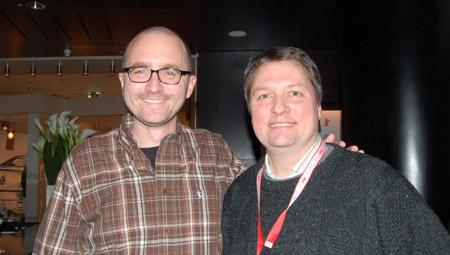 Schawn
Belston (20th Century Fox) and Thomas Hauerslev (in70mm.com). Image by Maria
Hauerslev Schawn
Belston (20th Century Fox) and Thomas Hauerslev (in70mm.com). Image by Maria
HauerslevI also met Schawn Belston who is head of 20th Century Fox library services in Los Angeles. I have been cooperating professionally with Schawn for many years, but this was the first time we shared the same room. Schawn has always been very supportive to my 70mm activities, supplying their new Todd-AO 70mm prints for the enjoyment of the guests in Bradford, Karlsruhe and in Copenhagen. |
17.03.2009 Hi Indiana Jones - Thomas, Your Berlinale report is great - congratulations - really professional! Jürgen A. Brückner Kinematek Coburg, Coburg, Germany |
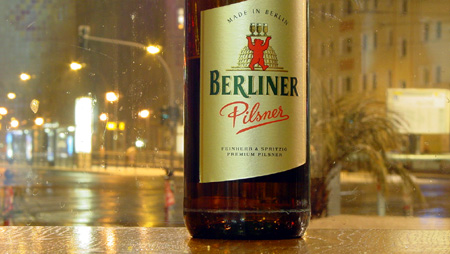 The
Berliner Pilsner. Image by Paul Rayton. The
Berliner Pilsner. Image by Paul Rayton.I had a good glass of Berliner Pilsner, the local brew. It was great, once again, to be in the middle of the 70mm "melting pot" with good friends and a beer. Schawn told me he was going to reprint some of his 70mm titles, thanks to popular demand. I took pictures before we left the reception, and then we proceeded across the road to listen to a lecture at the Deutsche Kinemathek by English film historian Kevin Brownlow titled “From Biograph to Fox Grandeur. Early Experiments in Large Format Presentations”. We came in just before the lecture began and found some good seats in the first row. |
|
“From Biograph to Fox Grandeur. Early Experiments in Large Format Presentations” |
|
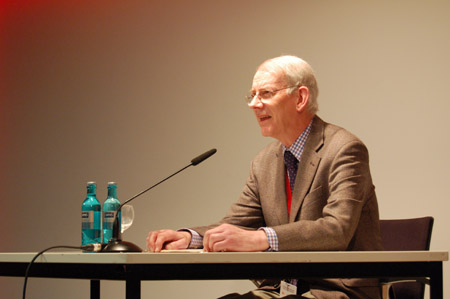 Kevin
Brownlow during the lecture. Image by Thomas Hauerslev Kevin
Brownlow during the lecture. Image by Thomas HauerslevKevin Brownlow, who I had met previously in Bradford, gave a fine and interesting talk about the early days of large format presentations – which ultimately led to the birth of Cinerama and Todd-AO. Mr. Brownlow is famous for several things, including restoring Abel Gance’s “Napoleon” (1927), photographed to conclude with a first of its kind - and very famous - Triptych (a three screen presentation process). Brownlow met Gance personally and he mentioned many amusing anecdotes including a story about Abel Gance visiting The British Film Institute in London many years ago. Mr. Gance was recognised by the BFI door man, because Brownlow had shown him an image of Gance only days before. Gance was totally surprised and overwhelmed to be recognized by the man. "We better call Brownlow", the BFI reasoned, and the whole incident led to a reception in Gance's honor. |
|
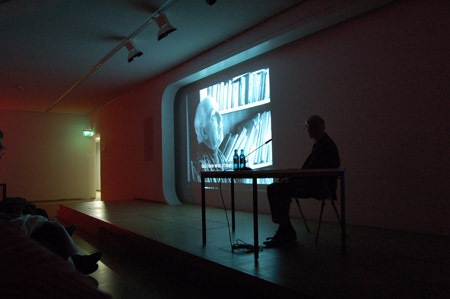 Abel
Gance is seen on the video projection image on the wall. Image by Thomas
Hauerslev Abel
Gance is seen on the video projection image on the wall. Image by Thomas
HauerslevBrownlow continued to tell the story of German inventor Max Skladanowsky, who showed film in Berlin at least a month before the Lumiere brothers in Paris – and Brownlow was puzzled why this fact is still unrecognized. Some days later Clemens Scherer showed me the machine Max Skladanowsky used, in the Potsdam Filmmuseum, and explained why it wasn’t recognized as being the first film: Max Skladanowsky’s projector was in reality two slide projectors, each with a film of stills. The two rolls of slides alternated picture by picture, and thus created an illusion of movement. Well, there we have it: a fine point in the technical definitions trips up Max's invention. The story of early widegauge film is documented in several books, and it was nice to listen to Brownlow's version, which was inspired with his own comments of disbelief at times. He was sure that authors may have embellished the facts when writing their stories many, many years ago. He enjoyed telling us about Cinerorama and using the word “Decagonal” for the first time, to describe a circular screen. The system was used in only one cinema accommodating some 200 people in Paris. The audience would be standing as if they were flying in a balloon from Paris to some place in Belgium. The film was photographed with 10 x 70mm cameras and shown with 10 x 70mm projectors. According to the history, the show only ran for 3 days, being closed by the authorities because of the danger of fire. |
|
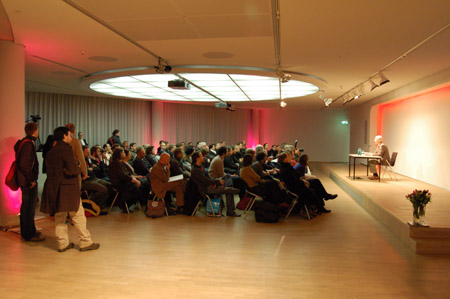 A
well attended lecture. Image by Thomas Hauerslev A
well attended lecture. Image by Thomas HauerslevDespite all the efforts for introducing widegauge in cinemas, Brownlow claimed only 20 North American cinemas were ever equipped with projectors for 63, 65mm and 70mm films in the very early days. And that number included Spoor/Berggren’s Natural Vision and Magnascope for “Wings” and “Old Ironside” presentations. He showed us a couple of video film clips that included triptych scenes from “Napoleon”. The second video clip showed a famous scene from “The Big Trail”, properly shown in 2:1, where wagons are lowered down from a tall cliff. There was no q/a after the lecture and about 150 people attended his lecture. |
|
Russian Expressionism in 70mm |
|
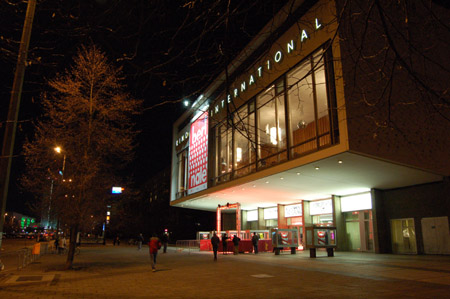 The
Kino International. Image by Thomas Hauerslev The
Kino International. Image by Thomas HauerslevOur day was far from finished. We checked in to the Berlin Hotel. Maria and I got the the key for room “1570” – must be the "IMAX Suite" we joked. Herbert drove us to the Kino International. We had dinner next door in a Spanish restaurant before the film. We saw the 20:00 performance of the Russian “Dnewnyje Swjosdy” / “Tagessterne” / “Star of the Day” from 1966/68 directed by Igor Talankin and starring Alla Demidowa, Andrej Popow, Konstantin Baranow. Running time was 94 minutes and it was subtitled on the spot into English by the German Cinematheque. It didn’t really help me, and Maria didn’t like the movie at all. “Star of the Day” is very rare 70mm print loaned to the Berlinale from Gosfilmfond in Russia, probably the only existing print of this film. The film was one long “stream of consciousness” type of narrative, which I had a hard time to follow. But perhaps that was also intended. It turned out to be the only complete film we saw, due to the late programming of the 70mm films. |
Hotel Berlin, Berlin Lützowplatz 17 10785 Berlin Germany The Hotel Berlin with 701 roms is in the heart of the German capital, just minutes from the Government district, the Kurfürstendamm and the Potsdamer Platz away. Complimentary WiFi in the rooms. |
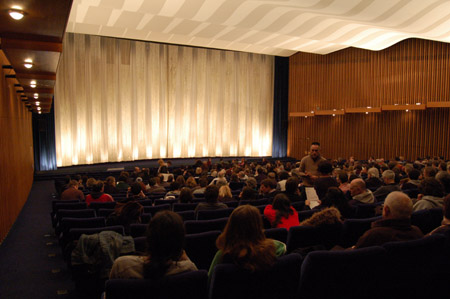 The
beautiful interior of the Kino International. Image by Thomas Hauerslev The
beautiful interior of the Kino International. Image by Thomas HauerslevMost 70mm Retrospect films were shown at 20 and 22/22:30 in the evening in two cinemas. The 22 performance is a bit too late for me. Being “an early bird”, I simply fall asleep if I watch movies after a long day. It didn’t matter much, as I have seen most of the retrospective films anyway. “Dnewnyje Swjosdy” was very grainy, a little on the pink side, and not showing off 70mm in all it’s glory at all, but it is a miracle that this print still survives, and the organisers are to be congratulated for including this film. Only on rare occasions can Russian 70mm films be seen the way they were intended. Connie told me the print was mechanically in very bad condition. The Russian Archives have many 70mm films in stock, but no funds to preserve them, unfortunately. Some sources say more than 160 Russian films were produced in large format Sovscope 70. |
|
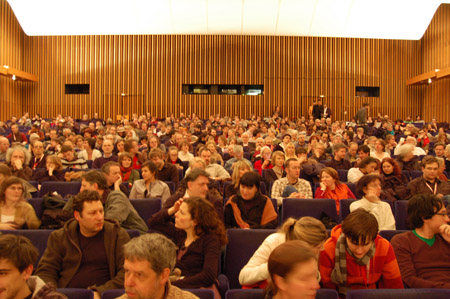 A
good audience full of anticipation for 70mm at the Kino
International. Image by Thomas Hauerslev A
good audience full of anticipation for 70mm at the Kino
International. Image by Thomas HauerslevAgain we met Jan Olsen and Torkell Sætervadet, this time in the foyer. Torkell is working for the festival as technical advisor for the DP70s at the Kino International. Jan, in his capacity of working for the Norwegian archive, is responsible for some of the Russian 70mm prints being shown here (some of which are actually with Danish subtitles). Great guys, and Jan recently became a father to a "70mm baby daughter" named Wilma after the Flintstones cartoon character. Caught a glimpse of Jean-Pierre Gutzeit, local Berlin eccentric and self-proclaimed 70mm "expert" in the midst of some kind of heated conversation with Kino’s staff. Probably complaining about something. Saw him again after the film, but only managed to say "hello". I think he was on his way to the “Hello, Dolly!” screening at the Cinestar 8. The Kino International, at Karl-Marx-Alle 33 is a listed and historical structure and a jewel in Berlin’s array of cinemas. It opened in 1964 and has a big shallow curved screen, nicely dimensioned for the 70mm format. The 14 m x 6 m screen is covering the whole end wall of the cinema. There are 551 seats and wheelchair access. |
|
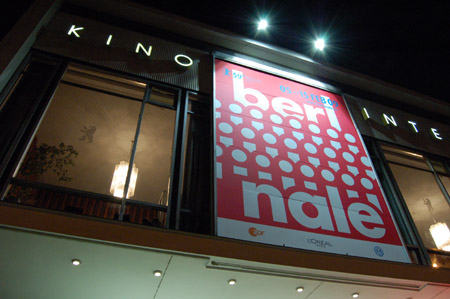 Grandiose
poster. Image by Thomas Hauerslev Grandiose
poster. Image by Thomas HauerslevFrom the festival brochure: “It belongs to the most impressive buildings of 'GDR modernism'. A classical movie theatre with a grand foyer, twin staircases, comfortable seating, exquisite paneling and a sequined curtain in front of the screen, the International still exudes the atmosphere of a time when it was a show-piece of an optimistic GDR culture. During the Berlinale 2009, films from the Retrospective and the Panorama are shown here. Selected Panorama films are premiered at the International.” |
|
Dolly at the Cinestar |
|
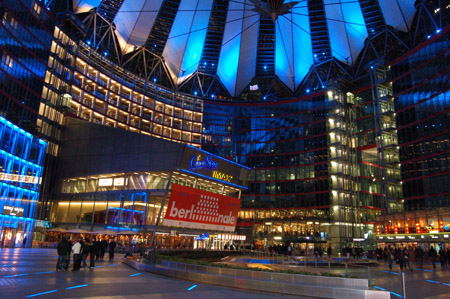 Under
this IMAX cinema and "Blade Runner"-like setting is the Cinestar 8. Image by
Thomas Hauerslev Under
this IMAX cinema and "Blade Runner"-like setting is the Cinestar 8. Image by
Thomas Hauerslev Following the performance of “Star of the Day” we went to the Cinestar 8 in the Sony center on Potsdamer Platz to listen to Schawn’s “Hello, Dolly!” introduction at 22:30. I met Grover Crisp who had been in charge of striking the new 70mm prints of “Lawrence of Arabia” and “Lord Jim”. I also bumped into Andrew Oran from FotoKem. Andrew and his lab are responsible for many of the new 70mm prints which have become available the past few years, including the re-printing of "Flying Clipper". The “Hello, Dolly!” (recent 70mm print from "Technicolor" company) performance was a near sell out. Many waited in line to get access to the cinema. A good buzz and more proof of the popularity of the old 70mm classics, when they are presented in 70mm. “Show them, and they will come” could be the motto. |
|
 The
Cinestar 8. Image by Thomas Hauerslev The
Cinestar 8. Image by Thomas HauerslevThe colors are great and I think it looked very good at the Cinestar. They played it loud, which I like and 6-track DTS sound came out of every speaker. Of course these days, there is no such thing as magnetic sound any more. Magnetic sound was phased out a few years ago because of environmental concerns and has been replaced by a DTS time code which corresponds with a DVD-ROM in a computer. The sound is stored on this DVD, but it can also be copied to a server, where you can have many soundtracks stored at the same time. Herbert and I saw the first reel of film and went back to the hotel bar to have a large beer. A long day had come to an end, and there were many impressions to be absorbed. |
|
Monday, 9. February 2009 |
|
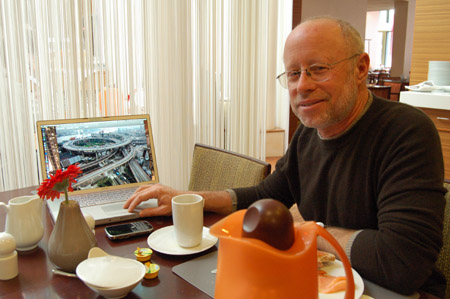 Mark
Magidson and location stills from "Samsara" on the Mac. Image by Thomas Hauerslev Mark
Magidson and location stills from "Samsara" on the Mac. Image by Thomas HauerslevMaria and I were hungry and looked forward to the breakfast, where we met Herbert and Mark Magidson in the restaurant. Mark showed us still images from the locations of “Samsara”, the new 70mm film by Ron Fricke. Judging from the stills, it will be equally as interesting and at least as beautiful as “Baraka” is. Premiere is predicted to be in 2010. Andrew Oran (FotoKem) joined the gathering just as we were leaving. This morning we had to do some historical sightseeing to the famous Bendlerblock building close to our hotel. The recent Bryan Singer film “Valkurie” tells the real-life story about an attempt to remove Adolf Hitler and his Nazi regime from power on 20. July 1944. Maria and I had just seen the film, liked it a lot, and I thought it would be interesting to see where the events took place 65 year ago. There is a museum on the first floor in the building about the efforts by Claus von Stauffenberg and the people who joined him in their effort to remove Hitler. The courtyard is a quiet place of remembrance with a plaque on the wall and a statue in the center. Some of the film was photographed here which added an extra dimension to our visit. |
Berlin people Gerhard Fromm flying in for a lecture about German 70mm systems MCS 70 and DEFA 70. Paul Rayton flying in on Thursday and departing again on Sunday. Schaun Belston (20th Century Fox), Andrew Oran (FotoKem) and Grover Crisp (SONY/Columbia). Friends of 70mm films including Hans Helf, Ingolf Vonau (Delphi Film Theater), Jean-Pierre Gutzeit and Clemens Scherer Jan Olsen & Torkell Sætervadet from Oslo, Norway. Bendlerblock Checkpoint Charlie |
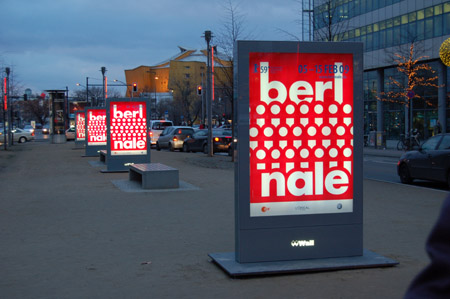 Berlinale
posters. Image by Thomas Hauerslev Berlinale
posters. Image by Thomas HauerslevMaria and I continued on foot to Potsdamer Platz to take some pictures of Berlinale Posters and the cinemas. Herbert joined us a little later and we all went looking for Checkpoint Charlie and Brandenburger Tor. I don’t think any 65mm films have been photographed there, but so much history surrounds the location that we simply had to see it. We also drove via Alexanderplatz to the Kino International because I needed some daylight pictures to supplement the pictures I took the previous evening. We looked for Torkell Sätervadet, but he was only there when they run 70mm, we were told. I wanted to see the DP70s in projection, but unfortunately we were denied access to the projection room. Not very sportsmanlike. |
|
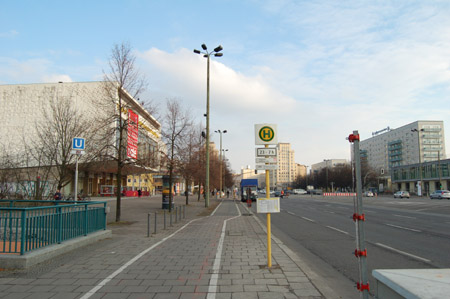 The
Kino in the concrete desert of the Karl Marx Allee. Note the
"U" sign at left for the subway, and the "H" sign on the street for the bus.
Very convenient access. Image by Thomas Hauerslev The
Kino in the concrete desert of the Karl Marx Allee. Note the
"U" sign at left for the subway, and the "H" sign on the street for the bus.
Very convenient access. Image by Thomas HauerslevThe Kino is located on the very wide Karl Marx Alle. It is fairly close to Alexanderplatz, and the U-bahn station Schillingstrasse is immediately beside it. The whole area around Alexanderplatz, which is the “old” center of DDR Berlin, is being redeveloped at the moment with lots of traffic. Almost opposite the cinema is a Media Markt, a very large consumer electronics shop. We went there to browse Blu-rays and I found two discs I needed for my collection: Kubrick’s “Eyes Wide Shut” and Ron Fricke’s Omimax film “Chronos”. It is somehow ironic to visit a shop like Media Markt. Really huge flat screens and high definition images everywhere you look. The consumer market is spending millions on marketing, telling us how the home cinema experience is "just like a cinema". The same thing cannot be said about cinemas. I think cinemas can - and should - learn a lot from the consumer market and re-invent the cinema going experience. 70mm is one way of doing that. Cinemas rarely advertise how good an experience it can be to go to the movies. They take it for granted. No wonder the home consumer movie market is doing so well. |
|
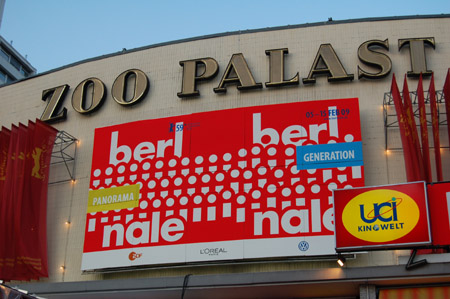 The
Magnificent Zoo Palast. I love those letters. Image by Thomas Hauerslev The
Magnificent Zoo Palast. I love those letters. Image by Thomas HauerslevIt was late in the day, and I wanted to go to the old center of West Berlin, around Kurfürstendamm, to see the Zoo Palast and maybe find the Delphi cinema and say hello to Ingolf Vonau, passionate DEFA 70 expert, always a nice chap and pleasant company. He'd also visited Copenhagen in April 2008, so this was our courtesy return visit. Herbert drove us across town to the Zoo Palast, a large 9-screen cinema participating in Berlinale events. The Zoo Palast is right in front of the Gedächtniskirche on Hardenbergstraße and until recently, it was the home cinema of the Berlinale. The cinema looked beautiful with it's huge letters on the building spelling "ZOO PALAST" and decorated in huge Berlinale posters and colors - bright red. Inside the foyer was a group of people talking, trying to get tickets. They were Danes. It was typical of our short visit to hear Danish everywhere. Berlin has become a very popular place to visit. |
|
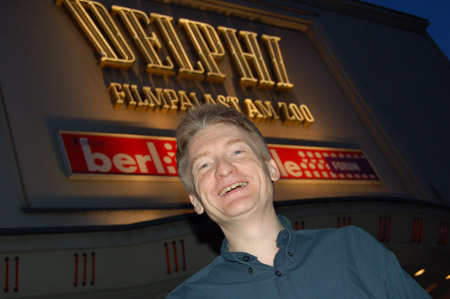 Ingolf
Vonau outside his cinema. The Dephi. Image by Thomas Hauerslev Ingolf
Vonau outside his cinema. The Dephi. Image by Thomas HauerslevWe found the Delphi cinema in the neighbourhood and by luck, Ingolf was there. He showed us around in the projection room. A classic older cinema with 700 seats. The Delphi has two entrances, the main entrance at Fasanenstraße with a big yellow neon "DELPHI" sign on the front. But there is also an entrance, through the restaurant, on Kantstraße, and also with a huge "Delphi" sign on the building. The original owner wanted the train passengers on the nearby railroad to be able to see the Delphi before they arrived in Berlin central station (The Delphi can be seen off to your left as you approach the Berlin Zoo station from the west). It is nice to see a cinema with a BIG neon sign. I like that. It spells C-I-N-E-M-A! to me. The projection room was equipped with 2 DP75s and a temporary digital projector for the Berlinale. Ingolf is keeping the small room in good condition and he has a large collection of historic documents and manuals on his book shelves. |
|
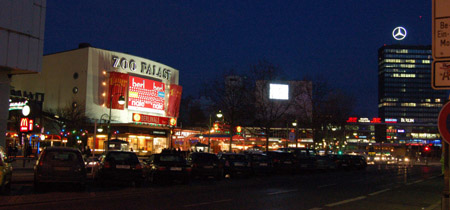 Zoo
Palast late in the afternoon. Image by Thomas Hauerslev Zoo
Palast late in the afternoon. Image by Thomas HauerslevMaria was very tired and we walked home to the hotel to relax for some hours. Originally we had planned to see “The Story of the Flaming Years”, but Maria was not too keen on the idea of another Russian “epic”, and honestly, I didn’t have the need to see it. Years earlier I had run that 70mm print in Denmark, so I have ticked it off on my list already. “Cheyenne Autumn” would have been interesting to me, as I have never seen it, but I also understood it was sold out. Later I heard the Swedish “Cheyenne” 70mm print was not as faded as one would expect, in fact several reports indicated the colors were still good. The Swedish film archive in Stockholm is famous for their large collection of vintage 70mm prints. The prints are stored in very cold conditions, which seems to slow down the fading process, but cold storage is not so good for the magnetic stripes on the film, a Swedish archivist told me. In any case, we didn't go to the movies. |
|
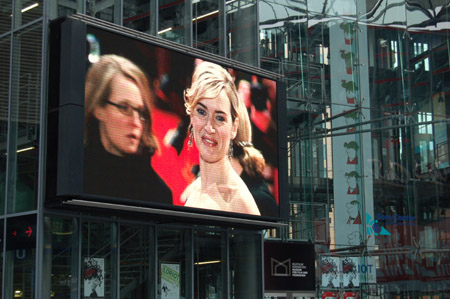 We
didn't see any stars live, however, Kate Winslet was in Berlin too. One of
her very first roles was in "Hamlet" in 70mm, which for some reason was
missing from the retrospective. Image by Thomas Hauerslev. We
didn't see any stars live, however, Kate Winslet was in Berlin too. One of
her very first roles was in "Hamlet" in 70mm, which for some reason was
missing from the retrospective. Image by Thomas Hauerslev.After a few hours at the hotel, Maria and I took the Berlinale shuttle bus from the hotel to Potsdamer Platz to "breathe in" the festival atmosphere, maybe catch a glimpse of Keanu Reeves, take some pictures and find something to eat – and maybe a good beer for me. Herbert had recommended a brauhaus next to the Cinestar cinema and we went in there. Maria likes schnitzels and so do I. I called Herbert and told him we were at the Brauhaus. Back at the hotel Herbert and I met at the bar for a last beer of the day – a Berliner Pilsener. |
|
Tuesday, 10. February 2009 |
|
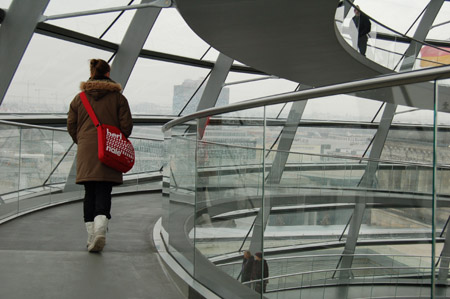 Belinale
guest doing sight-seeing. Image by Thomas Hauerslev Belinale
guest doing sight-seeing. Image by Thomas HauerslevUnlike Monday, we had an early start and met Herbert in the salons around 8:40 for breakfast. The previous day, we'd wanted to see the Bundestag’s glass dome. Found a long queue then, which would have cost us one hour of waiting time. We'd decided to come back today instead. Maria and I walked right in, and only minutes later, we were on the roof to enjoy the architecture of this unique building. Despite the strong wind and rain, it was enjoyable. Herbert remained in his car to do phone calls related to his cinema business in Karlsruhe. After the dome visit we headed to Potsdamer Filmmuseum to see the DEFA 70mm camera on display. Along the way in the car, we cheerfully listened to the roaring soundtrack from "How the West Was Won". Very appropriate, as we were also going to the "promised land" of DEFA 70. On the way we picked up Clemens Scherer on Alexanderplatz and 30 minutes later we were in Potsdam around 30 kilometres from Berlin, where we parked the car behind the "Potsdamer Filmmuseum". |
|
Filmmuseum Potsdam and the DEFA 70 camera |
|
 Clemens
and Herbert investigating the DEFA 70 camera. A huge machine. Image by
Thomas Hauerslev Clemens
and Herbert investigating the DEFA 70 camera. A huge machine. Image by
Thomas HauerslevPotsdam, famous also for the Babelsberg studios, where over-rated Quentin Tarantino is currently filming, the film museum shows the history of the DEFA film company (Deutsche Film AG) and I recommend the place. It's not immense, but with much attention to detail. Apart from the DEFA 70mm reflex camera, which was our main point of interest, they also have a pair of Russian hand held 70mm cameras on display (Unlike Hollywood in the west, the Russians and East Germans used 70mm ORWO negative stock in their cameras). DEFA’s history is well chronicled with many pictures and props from the movies; including material from three DEFA 70 70mm films; “Orpheus in der Unterwelt”, “Eolomea” and “Goya”. DEFA, by the way, originally was known as UFA, famous for many Marlene Dietrich movies in the old days. Our main interest was the camera. It is a very big machine, almost the size of a washing machine. It is blimped and shaped like a shoe box. I was very happy the museum has this camera on display so we could have a look. There is a cinema in the building with a fully working cinema organ installed behind the screen and viewable from the side through a window. The cinema is used every day and on occasion have celebrity guests such as Roman Polanski. |
|
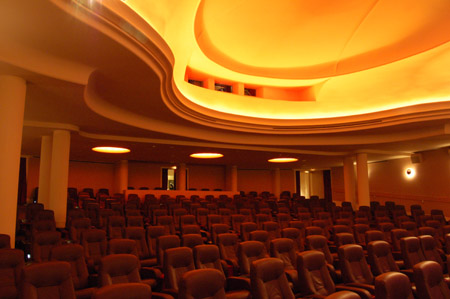 Beautiful
Astor Cinema Lounge. Image by Thomas Hauerslev Beautiful
Astor Cinema Lounge. Image by Thomas HauerslevOn our way back to Berlin, Maria and I asked Herbert to let us off at Kurfurstendam so we could see some of it for a second time. Before the re-unification in 1989, Kurfürstendam was the main center of the west side of Berlin with expensive shops, large kaufhauses, and, of course large cinemas, like the Royal Palast. Much to the dismay of many Berliners, the Royal Palast was demolished some years ago and is now replaced by real estate development including a huge Saturn media shop. There are still cinemas on "Ku’-damm", including the Astor Cinema Lounge with a single DP70 (Serial #1472) left. That projector is never used and theatre hasn’t played 70mm the past 10 years. The manger told me the last films in 70mm were “The Wall“ and “The Big Blue”. It started to rain again and we went back to the hotel to relax for some hours before "The Retrospective 70mm Reception" at 21:00 in the Filmhaus on Potsdamer Platz. |
|
The official Retrospective reception |
|
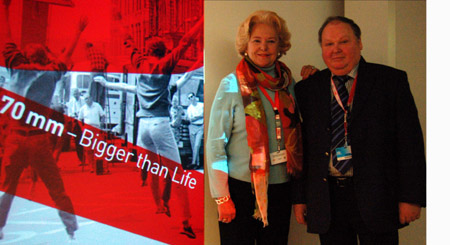 Hannelore Bollmann
Cantor and
Jürgen Brückner doing the 70mm poster pose. Image by Thomas Hauerslev Hannelore Bollmann
Cantor and
Jürgen Brückner doing the 70mm poster pose. Image by Thomas HauerslevThe official Retrospective reception is a good place to meet people, as most of the 70mm guests from archives, studios and specialists will be there, Connie told me. Herbert, Maria and I arrived around 20:50 and stayed until 22:30. Plenty of red and white wine made the reception a very nice mid-week 70mm Retrospective occasion. I’d say that about 150 people were there for the reception, including Hannelore Bollmann Cantor, former German actress and owner of "Flying Clipper", Morten Skallerud ("A Year Along the Abandoned Road"), Andrew Oran (FotoKem), Connie Betz (Deutsche Kinemathek), Jürgen Brückner and many more I didn’t know. Jürgen Brückner had bought the theatrical rights for "Flying Clipper" from Frau Bollmann some 25 years ago. He then had a new 70mm print and some 35mm prints made. The 70mm version toured Germany for a long time and it was shown once a week in Munchen for the better part of a year. License eventually returned to Frau Bollmann Cantor. She eventually offered the 65mm negative and sound elements to the German Bundesarchiv-Filmarchiv. |
|
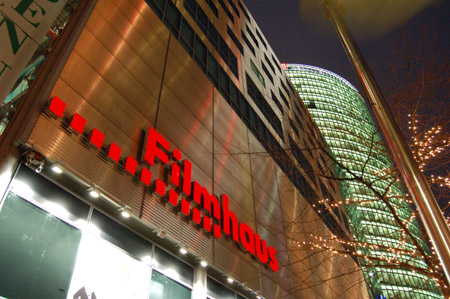 The
Filmhaus on Potsdamer Platz dressed in evening glory. Image by Thomas
Hauerslev The
Filmhaus on Potsdamer Platz dressed in evening glory. Image by Thomas
HauerslevTowards the end of the reception, I said thanks to Connie for the kind invitation to come to Berlin and good bye, as Herbert, Andrew, Maria and I went downstairs to the Cinestar 8 to see the first reel of ”West Side Story” in Super Panavision 70. It turned out that the relatively new 70mm print they were supposed to show had been damaged in one of the reels, so at the last minute a NEW new print was provided by MGM. The print actually shown was made very recently by FotoKem, from the current dupe 65mm negative, especially for the Dutch Filmmuseum, which is the distributor in the Benelux countries of special 70mm films. The sound for ”West Side Story” is re-mixed in 5.1, which is 3 front channels, left and right surround and a sub woofer channel – all presented in standard DTS. Whatever happened to the original Todd-AO 6 channel mix and why is that not available with this new print of Robert Wise’s masterpiece and winner of 10 Academy Awards? Herbert and I finalized the day with a Berliner Pilsener in the hotel bar. This was the third evening, so by now it's a tradition. |
|
Wednesday, 11. February 2009 |
|
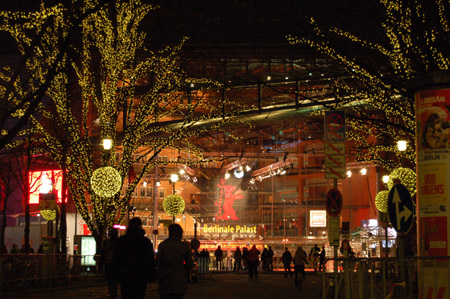 Berlinale
Palast during evening. Image
by Thomas Hauerslev. Berlinale
Palast during evening. Image
by Thomas Hauerslev.Our final day on this 70mm adventure started just after 7 in the morning in a bit of a snow storm which I could see from the hotel window. Maria was still sleeping while I read mail and news on the PC. We met Herbert for breakfast at 09:30 and checked out soon after. I became very impressed with the size of the festival. The Berlinale ranks as number 2 after Cannes film festival, I understand. Many cinemas all over Berlin, including the Cinestar and CinemaxX, near the festival center on Potsdamer Platz, and the Delphi, Paris and Zoo Palast around Kurfürstendamm and of course the Kino International on Karl Max Alle, are all showing films for some 12 hours a day. It is an immense 10 day film festival with film prints distributed from cinema to cinema all over the city. The Berlinale is famous for its audience-friendly approach that makes it very popular. |
|
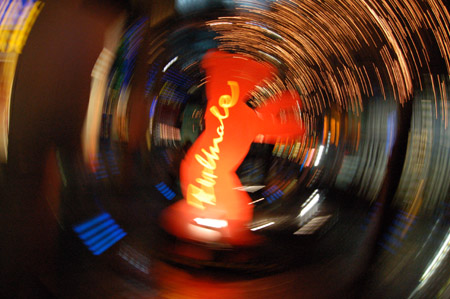 Image
by Thomas Hauerslev. Image
by Thomas Hauerslev.Every day I saw people standing in line waiting to get tickets. The festival center and cinemas are dressed in striking Berlinale posters which helps creating a unique atmosphere of intimacy and organization in the huge complex of buildings and streets. On Wednesday morning, the day we left, I heard that festival director Dieter Kosslick informed the media that 200.000 guests had seen films the first 7 days. That is a new record for the Berlinale. The 70mm Retrospective was but a small part of Berlinale, and yet a large program in its own right. 70mm turned out to be very popular with the audience. I understood that Connie Betz was very surprised to learn just how popular the 70mm films were, but also how dedicated some 70mm fans are. Many 70mm shows were sold out including classics like “West Side Story”, “Hello, Dolly!” and “Cheyenne Autumn”. By far, the Berlinale‘s most popular retrospective since the New Hollywood series in 2004, she told me. It will be interesting to see if the exposure 70mm has had during the 59th Berlinale will inspire others to show more 70mm. We can all hope. |
|
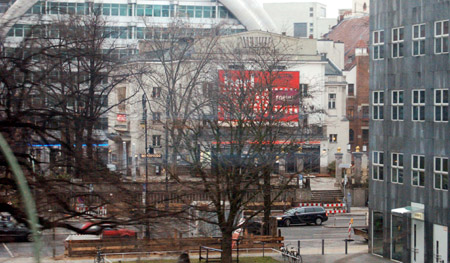 Last
2-second glimpse of the Delphi from the train - full speed. Ingolf was,
of course, right. You can see the Delphi cinema from the train when you leave
Berlin. Image by Thomas Hauerslev. Last
2-second glimpse of the Delphi from the train - full speed. Ingolf was,
of course, right. You can see the Delphi cinema from the train when you leave
Berlin. Image by Thomas Hauerslev.In Deutsche Kinemathek at Potsdamer Platz, we received some 70mm Retrospective posters for my 70mm file and that concluded the 70mm festival for us. Maria and I spent some time in the shops and looked forward to the trip home. Our train left Berlin Hauptbahnhof 15:26 and we spent nearly 7 hours on the comfortable train, thinking back on some nice days in Berlin. |
|
The return of "Flying Clipper" |
|
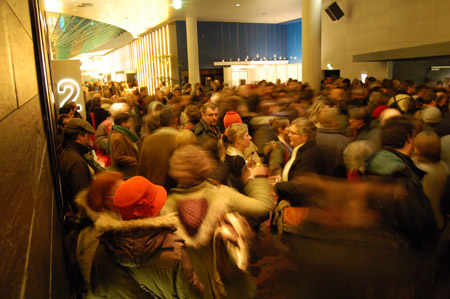 Audience
standing in line - sort of - at the Cinestar 8. Image by Thomas Hauerslev Audience
standing in line - sort of - at the Cinestar 8. Image by Thomas HauerslevThe festival continued until Sunday and one of the most anticipated films of the Retrospective was the screening of a new 70mm print of "Flying Clipper". West Germany's first 65mm film in their own MCS 70 process from 1961. The 65mm negative and 6-track sound is in the the Bundesarchiv-Filmarchive collection and, at great expense, the Bundesarchiv-Filmarchive reprinted the film specifically for the festival, and the big premiere was on the 11th in the evening. Before the screening Gerhard Fromm took part in a lecture hosted at the Filmhouse about German 70mm format DEFA 70 and MCS 70 - Superpanorama. Gerhard had worked on both systems and was a personal friend of Jan Jacobsen, the designer of the MCS camera series. Expectations were high when the audience gathered in the Cinestar 8 foyer for the big re-premiere. All had been going well during the festival until...disaster struck on the very night of the screening of the new print! It turned out that a electronic circuit card in one of the Kinoton FP75E projectors was not working, and a replacement was not readily obtainable. Not at 22:30 anyway. |
|
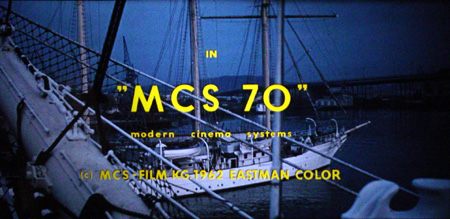 Process
title card from "Flying Clipper" from test screening in Los Angeles.
Image by Paul Rayton. Process
title card from "Flying Clipper" from test screening in Los Angeles.
Image by Paul Rayton.The audience had to wait in the foyer for an hour until it was finally decided to start the screening after all, but only on the one working projector. It would be 10 reels, one-reel-at-a-time - meaning 9 reel-change intermissions during the course of the film. "Flying Clipper" was scheduled to begin 22:30, and was delayed at least an hour. That turned out to be too late for many people, and some left. Even more people left during the intermission. It was very unfortunate for the screening and for the festival. "Flying Clipper" was rescheduled for the 15th in the morning at the Kino International and tickets bought for the Cinestar 8 screening were valid for the morning screening. When I heard this, I felt very sorry for the poor projection people and not least for the Retrospective people, who had worked so hard to make this screening unique. I also heard another story about the new the 70mm print: It will not, so the rumor goes, be made available for screenings outside the festival. That sounds too strange to be true. Film only comes alive on the silver screen, they must be shown to people, not be simply kept in cans. It will not make sense to spend a fortune to make a new print, to have it sitting in a film vault. I hope "Flying Clipper" will be made available for 70mm screenings in Karlsruhe and perhaps in Bradford. |
|
Official Retrospective Publication - "70mm – Bigger than Life" and more in print |
|
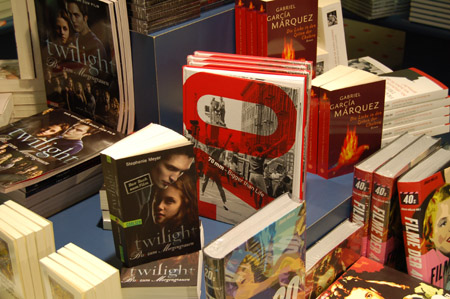 The
70mm book for sale. Image by Thomas Hauerslev The
70mm book for sale. Image by Thomas HauerslevOn the occasion of the retrospective Deutsche Kinemathek – Museum für Film und Fernsehen published a 166 page book about 70mm history. The book is available from amazon.de for only 19,90 Euros. Printed in black and white, it chronicles all the 70mm films shown during the Berlinale, and is written in both German and English language. "For many cineastes, 70 mm is far more than just the designation of a film size. Its large-format images combine high resolution, sharp picture and colour quality with overwhelming sound quality. 70 mm represents a unique kind of harmony, a code signifying cinema’s true potential: a singularly impressive experience for both the eye and the ear. This book is about the history and technical development of wide-gauge film. It contains an essay and glossary by Gert Koshofer, a comprehensive list of 70 mm film titles (with commentaries in some cases) covering productions from the USA, the USSR and Europe. There is also a data section, with detailed filmographic information and contemporary film criticism, documenting all the films in the Retrospective '70 mm – Bigger than Life'." |
|
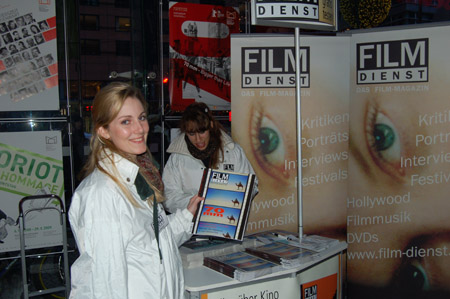 German
magazine "Film Dienst" made a special 70mm issue. Including
images by me - they have good taste. Image by Thomas Hauerslev German
magazine "Film Dienst" made a special 70mm issue. Including
images by me - they have good taste. Image by Thomas HauerslevContents copied from the German Cinematheque's web page: Rainer Rother: Size Matters. Vorwort [Foreword]. Gert Koshofer: Von Todd-AO bis Panavision Super 70 [From Todd-AO to Panavision Super 70]. Zur Geschichte des Breitfilms [A History of Wide-Gauge Film]. Gert Koshofer: Von Agfacolor bis Wonderama. [From Agfacolor to Wonderama]. Glossar [Glossary]. Gabriele Jatho und Gert Koshofer: Von BILLY THE KID bis SAMSARA [From BILLY THE KID to SAMSARA]. 70-mm-Filme [70 mm Films]. Klaus Hoeppner: Von BARAKA bis WOINA I MIR [From BARAKA to VOINA I MIR]. Die Filme der Retrospective: Daten und Kritiken [The Films in the Retrospective: Filmographic Details and Reviews]. Hinweise [Notes]. Register [Index]. |
|
Thursday, 12 February, 2009 |
|
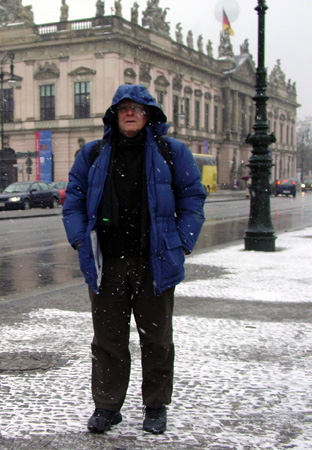 Paul
Rayton in Berlin. What's a trip somewhere without a photo???? This is my favorite,
even though it doesn't have any particular
images referencing the
Berlinale. I called it "BR-R-R-R-RLIN", as in -- on the cool
side, if you asked me.... That white dust in front of me is what
you might expect in February - snow. Image by Ingolf Vonau. Paul
Rayton in Berlin. What's a trip somewhere without a photo???? This is my favorite,
even though it doesn't have any particular
images referencing the
Berlinale. I called it "BR-R-R-R-RLIN", as in -- on the cool
side, if you asked me.... That white dust in front of me is what
you might expect in February - snow. Image by Ingolf Vonau.Today's the day our in70mm.com "tag team" relay went in to action. Thomas left town, and I arrived, continuing our extensive "team coverage"... Thanks to longish travel distances and times, I arrived into Berlin toward the end of Thursday afternoon. I proceeded directly from Berlin's "Tegel" airport, my suitcase in tow, via bus and train, to Potsdamer Platz, in an attempt to make it to at least a few moments of the 70mm seminar on cameras and photography, which had been scheduled to start at 17:00. I did get to the location around 18:00 -- but just as the seminar was ending, and was greeted outside by Ingolf and Johan Wolthuis. I had a chance to briefly look around the conference area in the very modern structure that holds the offices of Deutsche Kinemathek, as well as, in the lower levels, their affiliated theatre, Kino Arsenal, the 2-screen operation that shows art films year-round as a commercial cinema. Since the rest of the day's events would be screenings somewhat later on in the evening, and since I was just off a transatlantic flight, I thought I'd pass on seeing any movies this evening. I was still dragging along my suitcase when, as luck would have it, Ingolf said he had to leave more or less immediately, to drive to his theatre to work - and my hotel was on the way, and he could leave me off there. How wonderfully convenient! And thank you, Ingolf! After checking into the uniquely double-named "Hotel Berlin, Berlin" (yes, it's all part of the official full name!), and catching my breath, I decided some fresh air would be good and I'd walk the approx. 2 Km to Ingolf's Delphi Theatre, where they'd be having a Spanish [35mm] film ("The Mermaid and the Diver") on their screen, as part of the "Forum" series of the Berlinale. It was brisk, cool weather during my walk -- I was glad I'd brought my heavy jacket! At the Delphi, I looked around the projection room, as Thomas had before me, and saw the conclusion of the film, which would be followed by a Q&A with the filmmaker. (Interesting movie, but photographed on video and transferred to 35mm. Excellent attendance; theatre almost full.) I was still fascinated by all the new surroundings and stayed up much later than I might have (or should have), but when everything wrapped, Ingolf was kind enough to again drop me off at the hotel, and I proceeded to bed for the first time in, probably, 40 hours. |
|
Friday, 13 February, 2009 |
|
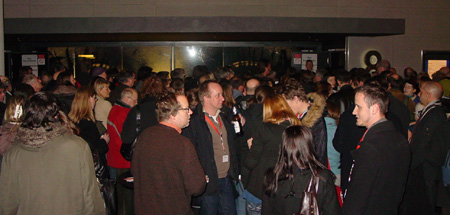 Crowds
in front of the Cinestar 8. Image by Paul Rayton Crowds
in front of the Cinestar 8. Image by Paul RaytonUnlucky "Friday the 13th"? Well, no serious disasters befell me this day, nor (to my knowledge) to anyone directly associated with me, so maybe there's less truth to that old story than we thought... At any rate, well, there was one little mishap -- I was still getting my directional bearings and, in the course of doing some city exploring on foot, I managed to get "west" and "south" a bit confused and proceeded to get myself somewhat mystified as to my exact location... Some might call it "lost". Eventually, with a fairly decent map in hand, I figured it out, and was then properly oriented. After the "where am I?" fiasco, I ultimately found myself, late in the afternoon, back at the Delphi Cinema, where I'd again see Ingolf after he finished his work for the afternoon. (I'd actually hoped to get there in time to see a bit of the afternoon Berlinale screening there, a show utilizing two 16mm projectors, projecting side-by-side images ("When It Was Blue"). However, due to my getting lost escapades, missed the whole thing. Oh well... |
|
 Albert
Einstein overlooking the restaurant named after him. Seated: Stefan,
Torkell and Ingolf. Image by Paul Rayton Albert
Einstein overlooking the restaurant named after him. Seated: Stefan,
Torkell and Ingolf. Image by Paul RaytonWhen Ingolf wrapped up his work, we briefly stopped through Potsdamer Platz, to arrange for some tickets for shows, and then headed for the Kino International. Tonight's big show was to be "Hello Dolly!". We met Torkell in the theatre lobby, and presently thoughts turned to ... food. Food? Who needs that -- we're going to be seeing 70mm! But no, really, we did need to have something, some real food, not just snacks. We went across the street to the adjacent restaurant/bar there, Albert's, and ordered some things from the menu. In a scene somewhat reminiscent of the "old days", we were told that a number of things listed on the menu were "not available". Oops -- flashback city? The days of the occupation, with menus listing many things which were never available...? Actually, in this case it turned out to be just that those selected items we'd seen were "daytime" selections, and the "evening" meal selections were different. Food (and a beer or wine, etc.) were ordered, and things went along fine. Schnitzel, for me, with fries, and broccoli (too done for my tastes, but a least it's a vegetable, anyway). We (Ingolf, Torkell, Stefan Scholz, and me) were seated at a table at the immediate base of the remnants of a somewhat battered old pipe organ, now dressed up with neon lights and, up above, a huge relief sculpture of some white-haired old gentleman up above the pipes. Was it Albert Einstein? I forgot to ask, but afterall, the place is named Albert's. The waitress seemed bemused by our group, and was hitting us up for some souvenir of the Berlinale events. Even a "used" or old ticket, she said. She kept bringing little items to the table (an aperitif drink. A tray of chips. Some after-dinner cookies, etc.) as if she didn't want us to ever leave! |
Alberts Berlin |
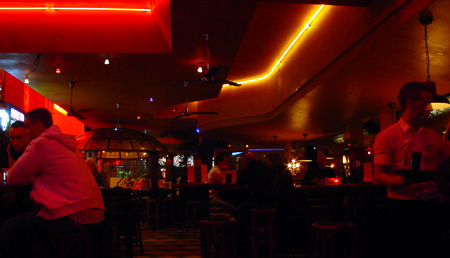 Albert's.
Image by Paul Rayton Albert's.
Image by Paul RaytonEventually, we really did have to go, as "Dolly" was getting threaded into the projectors across the street in the theatre, ready for the late-ish start time of 22:30. By this time, I'd missed the start of the other evening show for the night, "STAR!", screening at 21:30, across town at the Cinestar 8 -- and for which I was holding a ticket -- so I did give our waitress her Berlinale souvenir. Of course, by that time it was impossible for her to actually use (or sell) the ticket, but maybe she'll be thus motivated to be in attendance at an event some time in the future! Just prior to the start of "Dolly", Connie Betz took the stage and did a brief introduction and some acknowledgements, and then the show was started. I never quite understood how such a major musical as "Hello Dolly" didn't have a proper overture but ... it didn't, and so we leapt into the opening title sequence right away. A few felt that the sound was a bit too loud (an assessment I didn't share), but they were after Torkell right away to "turn it down". He was positioned at the remote fader at the back of the auditorium, and did his best to satisfy various souls, all of whom had differing ideas as to the appropriate playback level. (I remained out of the fray -- this was not my program). |
|
 "Produced
in Todd-AO" - probably the most cherished process title card by all fans of 70mm
film. Image by Paul Rayton. "Produced
in Todd-AO" - probably the most cherished process title card by all fans of 70mm
film. Image by Paul Rayton.The show looked decent enough on the big screen. Torkell admitted that there were some flaws to the screen, apparently some abrasions caused by the masking moving over the screen surface, which lent a slightly "scratched" appearance to the left and right sides of the images, if one looked closely. I myself also felt that the screen may have been in place for quite a while -- and that the venue had possibly (probably?) allowed smoking during the shows during years past -- so I'm not exactly sure how "white" it still was. [The screen is three years old and smoking was not allowed at this theatre - "comment subsequently added from Berlinale Offices.] The further effects of the undulating white ceiling, and the light reflections off it, also entered the picture quality equation. My notes, after the show, reminded me the picture seemed "lifeless". The vibrancy of the colors was, somehow, off. If I hadn't seen this exact same print in two other venues, I might have not have been able to make such comparisons, but there was clearly something (or some things) really wrong with this image on the screen, though probably not apparent to first-time viewers. After watching for a while, the effects of jet lag began creeping up on me, so I bailed out before it was over and went back to the hotel to tend to any urgent e-mails and get some sleep. |
|
Saturday, 14 February, 2009 |
|
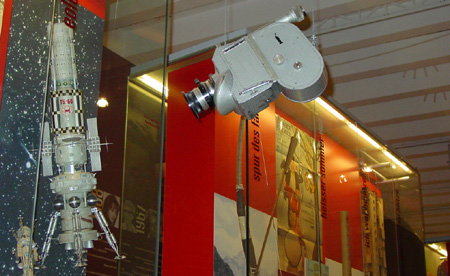 Russian
70mm camera and model from DEFA 70 "Eolomea". Image by Paul Rayton. Russian
70mm camera and model from DEFA 70 "Eolomea". Image by Paul Rayton.I had stayed up too late (again), but in the morning was up and ready for another fine breakfast. The buffet at the hotel is quite extensive, so you can eat yourself silly, if you so choose. I tried to behave... After breakfast, I assembled my cold weather clothing and was picked up by Ingolf for a auto trip to Potsdam (somewhat following Thomas' steps). The main reason, of course, was to see the Kino Museum there, with a special focus on their DEFA 70 camera, as well as the Russian 70mm camera specifically designed for hand-held photography by Cosmonauts while orbiting in space. There's a displayed sample of some 70mm images, (on 70mm film, with mag tracks) in a cabinet, but I didn't see any descriptive information as to whether it was a print of actual space footage or not. |
|
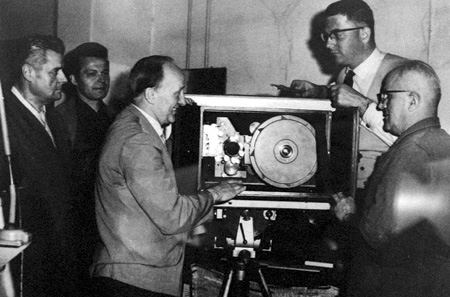 70mm
Camera DEFA reflex 1964. Camera engineers the from left to right Ernst
Petzer, Manfred Pillau, Georg Maidorn, Günter Stockmann, Albrecht Zörner
1964/65. Image of an image in Filmmuseum Potsdam by Paul Rayton 70mm
Camera DEFA reflex 1964. Camera engineers the from left to right Ernst
Petzer, Manfred Pillau, Georg Maidorn, Günter Stockmann, Albrecht Zörner
1964/65. Image of an image in Filmmuseum Potsdam by Paul RaytonWe also stopped by the main gate of Studio Babelsberg, and Ingolf showed me the building which contained the historic sound stage, where some classic E. German 70mm films like "Goya" had been mixed. The sound equipment is now seriously updated, and the room is used for contemporary shows these days. Parts of the Babelsberg "back lot" (as they called them in the US -- the open area used for sets, etc.) have been turned into an amusement park, following the lead of the "Universal Studios Tours" theme parks, but I was not interested in roller coaster rides this day. It was Saturday and most workaday activities in the studio were closed for the weekend, so we didn't see anything actually being worked on. |
|
 Babelsberg
studio gates. Image by Paul Rayton. Babelsberg
studio gates. Image by Paul Rayton.After Potsdam and Babelsberg, we drove back into Berlin. Each way, on the highway, we passed through some buildings alongside the highway, not unlike a service plaza along an expressway. In fact, to some degree, there are a few services located there. But ... in reality, it was the old "checkpoint" along the highway, entering or leaving from one sector to another. Potsdam was in the former "East" Germany, and in the old days, one would be stopped here to show papers and etc., to see if you were allowed to proceed. Now we can zip right through, although to see these areas reminds yet again how easy it can be to watch simple basic freedoms get away. Once back in Berlin, Ingolf went to work, and I was on my own for the afternoon. No 70mm screenings, so I did some more independent exploration, and riding a few trams here and there. Yes, there were Berlinale screenings all over the place during this time, but, since I was a first-time-visitor to Berlin, I didn't want to spend the entire time in darkened theatres, so -- outside it would be, for me. |
|
 People
behind the 70mm Retrospective lining up in front of the massive curtain
at the Kino Internatonal. Image by Paul Rayton. Click image to see
enlargement People
behind the 70mm Retrospective lining up in front of the massive curtain
at the Kino Internatonal. Image by Paul Rayton. Click image to see
enlargementFrom left to right: ?,?, Klaus Mueller,?, Torkell Sætervadet, Connie Betz, ?, ?, Michael Neisse, ?, ?, ?, ?, ?, ?. (waiting for additional names to be provided here) One thing led to another, and by pre-arrangement Ingolf and I re-gathered outside Kino International around 18:45, to meet and see a least a part of "Khartoum". No time for a meal this time (show scheduled for 19:15), so it was an energy bar from my pocket and then in to find a seat. Another introduction by Connie Betz, and this time she invited all the on-duty employees of the theatre to join her at the front of the stage, for some recognition for their efforts of the past week. It was a nice moment. Also receving a bit of an award was a rather nonplussed guy from a seat somewhere in the middle of the theatre who was brought up and given some kind of award -- his "claim to fame" was that apparently he was sitting in the specific seat formerly favored by former E. German Prime Minister (1971 - 1989), Erich Honecker, when he'd attend a show at the Kino International. This trivia piece was being commemorated this evening (but I don't know how often this is done). The whole "awards" portion was entirely in German, and, as one with extremely limited knowledge of German, I only got a sketchy summary of the proceedings. (Perhaps some reader can fill me in further!) |
|
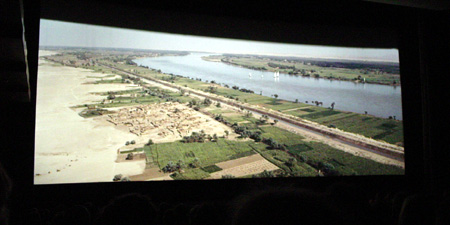 An
example of just how w i d e Ultra Panavision 70 is. The Berlinale showed
the film with the correct de-anamorphic lens. Image by Paul Rayton. An
example of just how w i d e Ultra Panavision 70 is. The Berlinale showed
the film with the correct de-anamorphic lens. Image by Paul Rayton."Khartoum" is preserved and presented now as a proper "roadshow engagement" type of print, i.e, with an overture and additional exit music, some of the trappings of a "big deal" movie. There is a spot at the end of reel #6 (I think it was) for, at the option of the cinema, an opportunity to have an intermission. In this evening's show, it was announced they'd decided to bypass the intermission because of the lateness of the hour, plus the fact that it's not really THAT long, at some 136 minutes. And so the movie started. The overture played wonderfully, the lights gradually went down toward the end of the overture, the curtain parted ... and we were transported to Sudan (soon after some of the events depicted in the film, it would become known as "Anglo-Egyptian Sudan"). The year is around 1885. The film starts with a bit of a travelogue (a typical Cinerama-esque opening), with aerial shots of deserts views, and the Nile River. Most of the viewers in the audience were, by now, "there", via the ultra wide screen of Ultra Panavision at 2.75:1 AR. Me, I was a bit bothered by the previously-described marks on the screen surface -- it made it look like the print was scratched. |
|
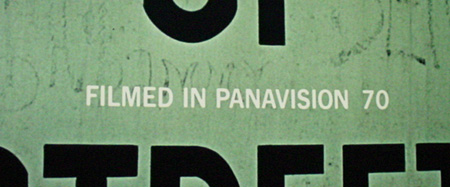 Before
Super Panavision 70 became really "super". Image by Paul Rayton. Before
Super Panavision 70 became really "super". Image by Paul Rayton.The movie was playing to a full house (or almost so). It was made in 1966, kind of as (if I may say so) a "wannabe" "Lawrence of Arabia". The same ingredients: vast desert, battling armies, an epic saga of a story. It never quite made it into the realm of a mega classic, like "Lawrence", but it's great to once again be able to see it played out this way on the big screen, as it should be. But not great enough. Ingolf and I had tickets for the later (21:30) showing of "West Side Story", back at Potsdamer Platz, so, presently we discreetly took ourselves out of the Kino Int'l., and headed for the Cinestar 8. At the Cinestar, the lobby was filled with people, charged with excitement, waiting to see this classic musical. The doors were opened and I availed myself of the preferential advance seating for "accredited" participants. Normally, I defer to others to see such events, and put myself in the crummy seats elsewhere, but this one time -- I'd have to go for a decent seat, partly because I was going to remain for the whole show. |
|
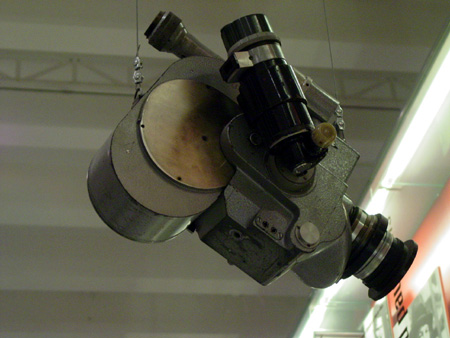 The
Russian 70mm hand held 70mm camera in the Filmmuseum Potsdam. Used on many
DEFA 70 film. Image Paul Rayton The
Russian 70mm hand held 70mm camera in the Filmmuseum Potsdam. Used on many
DEFA 70 film. Image Paul RaytonSuch it was that Ingolf and I found ourselves mid-theatre (albeit with me in an aisle seat), awaiting the introduction. On schedule, Connie Betz approached the front of the stage and introduced the screening, again with some acknowledgements and other thanks. Again, tonight, because of the late start and the film's relatively short running time, we would NOT be doing the intermission. And then -- the lights went down, and the "colorful overture" opening of "West Side Story" was under way. |
|
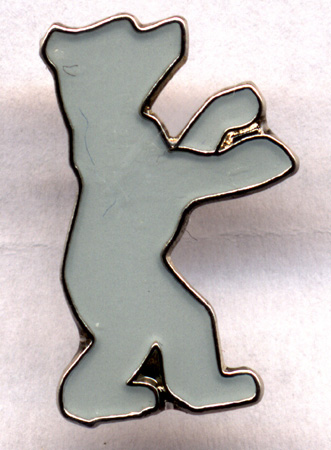 The
festival bear pin. Mascot of the Berlinale. The
festival bear pin. Mascot of the Berlinale.As you may have read earlier, the Cinestar theatre is a relatively newly-built theatre, with stadium-type seating. Good visibility. Large screen. Bright image. And the print was the newest of the new, only out of the lab for, like, 2 weeks, or less. A great presentation, a flawless print, and, if I may say so, a grand time was had by all. Technical note: the print is probably as good as we'll ever see this movie look. Some sections of the original negative have suffered various problems over the years, from improper storage to "overprinting", resulting in some challenging problems for lab wizards such as Andrew Oran at FotoKem to bring it back for us now. The sound is a fairly accurate simulation of the original mix, but it is hoped that before too long a full "5-across" (original Todd-AO) mix will be available to play with this same print, in theatres so equipped. One other technical note: the dowsers here are slow, so at each and every reel change, there's a momentary overlap, for a split second, when both machines are on screen! This is just projectionist-geek trivia. Not to worry, the show was otherwise fine! After the show (it's a bit of a tragedy, a "downer", if you will -- a lot of people die in the course of the movie), when the lights came up, a hushed silence hung over the audience. Gradually they made their way out into the lobby, and back into the "real world". Nice to see a film some 45 years of age can still have such an impact on the viewers! Hmmm -- now it's after midnight. Ingolf and I haven't had anything substantial to eat for many hours. He takes me to a 24-hour, very hip place, "Black Cafe", and we join a noisy, happy crowd, to have some good stuff as a late night light dinner. LOTS of people in there, and a fun place! After which, he drops me off at the hotel, and I make my way to bed, A.S.A.P. |
|
Sunday, 15 February, 2009 |
|
 The
slightly different look of ORWO color in this image from "Goya". Note
also the
curvature of the screen. Image Paul Rayton The
slightly different look of ORWO color in this image from "Goya". Note
also the
curvature of the screen. Image Paul RaytonOfficially, the Berlinale ended as of Saturday. But, apparently, they were having so much fun in programming that yet more screenings were scheduled today. And so, after breakfast, I made my way once again to the Kino International, for the screening of "Goya" (E. Germany, 1971), truly an interesting movie, and a very rare original 70mm print. Outside the theatre, I met up with another long-time 70mm advocate, Johan Wolthuis and his wife, from the Netherlands. We all sat separately, but were all there to see this unusual film, about the days toward the end of the life of the artist Francisco de Goya, when he was living in Spain and progressively going crazy. (or craziER). |
|
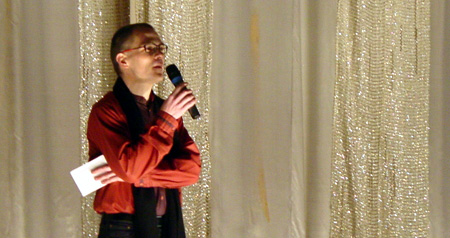 Another
introducer at the Kino. Image by Paul Rayton. Another
introducer at the Kino. Image by Paul Rayton.The film was introduced by one of the staffers, and off we went, into Spain in the 1881. The film was shot with the DEFA 70 camera, using ORWO film stocks. The image seen today was exactly what I'd expect from ORWO of the era -- minimal fading, possibly VERY slight shifting toward a blue hue, but entirely enjoyable. Very few scratches or other physical abrasions to the print. Soundtrack completely in German, and your humble correspondent had trouble following much of the specific action. Reportedly, there were to have been some subtitles simultaneously projected for us German-impaired viewers, but ... well, not today! And while I'm quibbling, the projectionists must have been partying out a bit last night, as they missed every change (very slightly), until the last one. Let's be fair to them -- it's possible the cue timing was slightly off, and they didn't pick up on that until the end. The glitches were minor, and only a fussbudget fellow projectionist like yours truly would pick up on it. But ... it was observed as sloppy! Following the end of the movie, we emerged out of the theatre into a world where a light snow had begun to fall. There would be no more 70mm films for me today in Berlin. We all (Ingolf, Johan & wife, and myself) proceeded to a fabulous coffee/tea shop near the Opera Houses in the Unter den Linden area, and enjoyed tea/coffee/cake until it was time for the Netherlanders to head for their train home. Later that evening, I'd join Ingolf at his home for a light dinner (while he sent his wife off to FINALLY catch "Lawrence of Arabia", in 70mm, so she'd FINALLY get some idea of the concept of "what's all this business about '70mm', anyway?") ! My Berlin visit was drawing to a close. |
|
Monday, 16 February, 2009 |
|
 Final
nod to the rich film history of Berlin: Not a medieval torture machine,
but Max Skladanowsky's projector in
the Filmmuseum Potsdam. Image by Paul Rayton Final
nod to the rich film history of Berlin: Not a medieval torture machine,
but Max Skladanowsky's projector in
the Filmmuseum Potsdam. Image by Paul RaytonToday I would have to be leaving Berlin. I had my final breakfast buffet, packed my stuff, and walked through the small accumulation of snow (1" -- maybe 25mm) to the local U-bahn (subway) station, to begin my return. Beautiful morning. If I'd had more time, I should have been taking photos for my next year's Christmas cards.... Fresh snow on the trees, wisps of snow in the air, crisp temperatures -- all the essential ingredients! Got back to Tegel Airport. It's a historic building, but exceptionally overcrowded now, having been overwhelmed by the latter day increases in air traffic. Bad. Bad. Bad. But, at least, it's handy to access the city's transit systems! It is scheduled to be closed very soon, and not a moment too soon, if you ask me! But the new airport will probably not be so handy. And so, I was back in the world of airlines and airplanes. And ... the usual delays. But that's a story for some other day.... 70mm rules in Berlin! Long may it run!! Thomas and I had seen so much -- and yet still missed so much. "Patton", "Ryan's Daughter", "2001", "Ben Hur". The restored "Play Time". The shorts. It was a feast of riches such has never been presented before, and we were so privileged to have been able to participate, in our own small ways. And our article here -- we hope it helps you also understand some of the excitement we also felt, during the Berlin Film Festival Retrospective of 70mm. |
|
Readers' comments are welcome,
Rayton and
Hauerslev
|
|
|
Go: back
- top - back issues
- news index Updated 22-01-25 |
|
